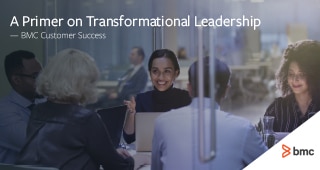Digital transformation (DX) can take many forms, depending on the industry and sector, public or private, within which it is undertaken. Some definitions of DX are limited to the IT department’s use of new technology to radically improve its performance; others expand the definition to include a business’s shift to a digital business model for new revenue and value-producing opportunities.
Regardless of how you define digital transformation, it has become clear to me that IT has often not kept pace with the speed of business change. A recent survey by the Economist Intelligence Unit shows that 66% of non-IT respondents seldom or never involve their IT groups when buying technology for digital transformation initiatives.
It’s critical to recognize that transformation is no longer a single event for most businesses, but a constant process—most especially for IT. Even further, for IT organizations to ensure the lines of business see them as partners critical to their success, they need to invest time and resources toward redefining themselves as technology enablers of business change.
Of course, that statement begs the question of “so, how do I do this with my IT team?” DX requires a focused program that addresses not only the technology, but also the people, processes, and data that align to it. This blog will cover five elements that allow IT to become the digital transformation enabler that your lines of business demand:
- Standardize, simplify, and automate IT
- Shift to agile methods of service delivery
- Improve governance to provide positive business value
- Move to a solution mindset within IT
- Prioritize people and employee engagement
Combining these five elements into an effective program will fuel your DX as well as advance IT from a cost center to a true business partner and enabler.
Standardize, Simplify, and Automate IT
When working with organizations, we frequently see complicated, meaningless, and illogical processes that intimidate users and waste valuable time. Additionally, there sometimes is an over-emphasis on processes, which can stamp out innovation and discourage creativity—and those are critical to DX for agencies and business alike. To be effective, processes need to be standardized (using out-of-the-box tools), measurable, accountable, repeatable, and time-bound—or SMART, as the acronym is commonly known.
In my experience, the simpler your processes, the more easily they can be updated to reflect the new developments and priorities of your organization. For this reason, ITIL® best practices for ITSM have become the accepted basis of improved service delivery. Instead of building on legacy manual processes often developed over time to suit unique needs, we recommend starting with simple ITIL processes that can be automated to eliminate inefficiencies and issues commonly associated with the integration of incident management and change management.
The greatest power and cost-efficiency of starting with automation of ITIL processes is regulatory compliance because it can easily enforce required best practices and generate the audit evidence that proves compliance. Integrated ITIL processes form the foundation of ISO 20000 certification, and that certification typically requires process documentation and proof of compliance, with evidence such as approved Requests for Change (RFCs). To fully harness the audit evidence power of automating ITIL processes, adopt and leverage an integrated set of core technologies that codify those IT processes within your service desk and extend this process model to include discovery, monitoring, and event correlation based on service models. Even further, by adding automation and orchestration tools to your service models, they act as the “glue,” bonding these major technical tenets into a functional foundation and providing speed and agility with which to respond to constant business change. Simple, efficient, and automated processes translate to less risk, reduced cost, increased productivity, and recognition of bottom line revenue.
Shift to Agile Methods of Service Delivery
We often see IT organizations remain too focused on traditional service management. These IT organizations are accustomed to sequenced tasks that lead to a final deliverable of a project and work on them in order. This methodology is referred to as “waterfall” and is the simplest to understand. However, when building and delivering IT services for the enterprise, the main goal is to meet user needs, and those needs change over time. That said, shifting to a more agile approach offers continuous service improvement based on user feedback, historical performance data, and changes in business requirements.
My Customer Success team at BMC was recently asked to help a 116-year-old company modernize its IT operations to go along with the new technology they purchased. While this US automaker can bring innovative cars to market, its IT operations were not necessarily able to deliver DX back to the enterprise as quickly as they would like. They turned to BMC to not only bring them best-in-class service management technology, but also to help their IT team learn new, agile ways of operating. First, we focused on developing simple service requests that captured critical data and were able to be implemented within a two-week period, as opposed to designing long, complicated services that would have taken longer to develop and deploy. We then ran a series of orchestrated sprints where we helped the company execute specific development tasks quickly and holistically. Prior to the sprints we executed standardization around forms across all lines of business (LOBs) to reduce duplication and unnecessary customization for common tasks and needs. With our mentoring and combined team efforts, we were able to release their modernized service desk to half their worldwide employees eight months ahead of schedule.
Adopting a more agile approach not only creates teams of empowered individuals, but when applied to service delivery, it also helps build a partnership with IT and the LOBs. That partnership involves working together to solve problems, improve services, and build better quality by incorporating feedback from iterative sprints, enabling a faster time to market and earlier return on investment.
Improve Governance to Provide Positive Business Value
We often encounter a siloed approach toward IT governance. The problem with siloed governance is that it can lead to redundant work and tools, poor organization-wide communication, and a lack of focus on organizational change management, often resulting in differing priorities between the business and IT. This experience is further underscored in the results of the Economist survey, which demonstrates that what IT understands to be a DX priority for the company is not aligned with what their counterparts prioritize in the LOBs.
When clients ask for our assistance to improve governance within their IT organizations, we often start by recommending that they include LOBs within their governance structure. This helps IT maintain visibility and alignment to future business changes while also assisting the LOBs in understanding foundational or core IT practices, standards, performance, and value measurements. This partnership with the business allows IT to learn about the LOBs’ needs and goals sooner and to provide critical training to ensure successful adoption of DX technology. Collaboration is a critical success factor in building confidence in DX programs.
Additionally, we recommend establishing communities of practice (CoPs) that are integrated within our customers’ governance structure to combine multiple similar technologies and resources into effective teams. This allows these groups to be brought to bear on new business challenges. While these CoPs may not be constantly activated for DX, they are an important factor when a prioritized DX endeavor must be responded to quickly and effectively.
Inclusion of LOBs and creation of CoPs improves IT governance by bringing a diversity of perspectives and skill sets together to help prioritize improvements, identify key activities, and act as a means for justifying what improvement proposals best align to major business objectives.
Move to a Solution Mindset within IT
We often see IT organizations struggling to mature from a product-centric focus to a more service-centric delivery approach. As previously mentioned, DX needs to plan and provide for continual business change, which will be best served by a solution-centric focus on how to achieve business value. A solution is something that solves a problem2 and often encompasses many components, activities, and skills to achieve the desired outcome.
Here is an example of a solution statement that our customers may respond to: “Deliver a more consumer-like experience from the help desk for customers and employees.” While our market-leading technologies can help, achieving the goal requires a combination of people and process shifts along with the right tools and capabilities. That said, we start with the technology components that have the capabilities of interest. It may mean utilizing several products that offer machine learning and artificial intelligence capability to design “chatbots” for basic service desk assistance without human involvement. The use of chatbots offers IT organizations the power to reassign vital IT resources to the higher-level tasks desired by LOBs. The people and processes then need to shift so that the IT professionals can align their time more effectively and allow the technology to fulfill the lower level services. In this simple illustration, you can see how technology along with people and process shifts can provide a true solution to the experience requested by the LOBs.
Prioritize People and Employee Engagement
Far too often we see DX increasing the pace of change and focused solely on technology adoption without effective employee engagement and enablement. From my experience, engaging employees at all levels of the business hierarchy and doing so regularly, most especially around DX, is a best practice. People perform better when they feel a sense of contributing to something important to the company, whether they are in IT or LOBs. According to Gallup, a lack of employee engagement costs American businesses anywhere from $450 billion to $550 billion a year in lost productivity.3 Conversely, employees who are emotionally and mentally connected to their organization work harder, stay longer, and motivate others to do the same.4
Amidst rapid organizational changes like DX, focused leadership and clear communication efforts are key factors driving successful employee engagement. Moreover, budgeting time and funding for formal organizational change management to activate new governance structures that address the human element as a core part of comprehensive DX programs is the most effective way to ensure robust employee engagement. This organizational change management would then include and outline frequent, clear, and two-way communications about various tasks and milestones in the change process to which employees are actively contributing. For me, I’ve seen the power of hosting open forums where staff can ask tough questions and get honest answers about the future state and its impact on them and how that drastically increases employee engagement and a sense of connection to the goals. As a leader, it is motivating to get many questions because it affirms that there is commitment to what we are trying to achieve.
As you can see, there are many elements that IT can utilize to become better enablers of DX for the enterprise. IT has the opportunity with these components to achieve more and help make DX a way of life where they are a key contributor to innovation. It’s fulfilling to see these things happen for enterprises and that’s why I enjoy what I do. These elements seem so simple that they are often overlooked, but they set a strong foundation for ensuring DX is effective and enduring, breaking the mold of outdated perspectives and approaches.
If your company needs help in transitioning to become a DX enabler, please fill out our form to speak to one of our experts and get started.
2 “Solution.” Merriam-Webster, Merriam-Webster, 2019, www.merriam-webster.com/dictionary/solution.↩
3 Sorensen, Susan, and Keri Garman. “Gallup.” Gallup, 11 June 2013, news.gallup.com/businessjournal/162953/tackle-employees-stagnating-engagement.aspx.↩
4 Weinger, Adam. “8 Results-Driven Reasons You Need Employee Engagement.” 8 Results-Driven Reasons You Need Employee Engagement, Double the Donation, 2015, doublethedonation.com/tips/blog/2015/09/why-employee-engagement-is-important/.↩







